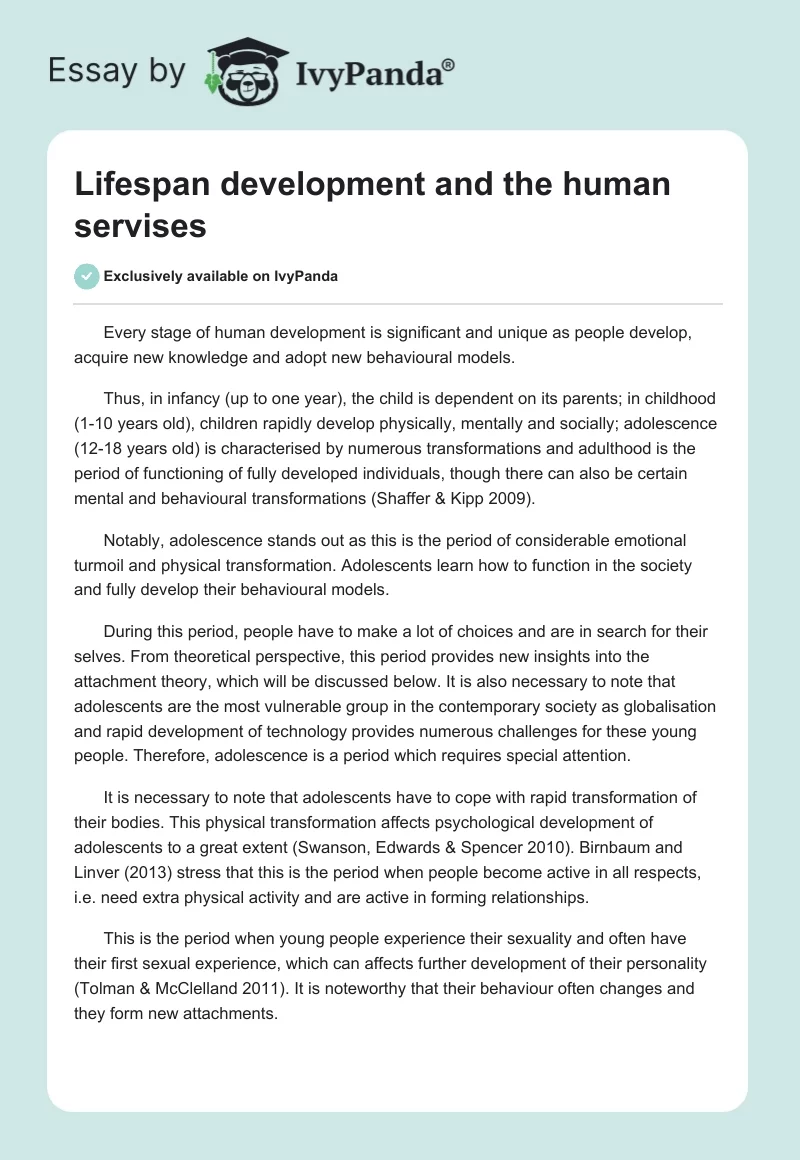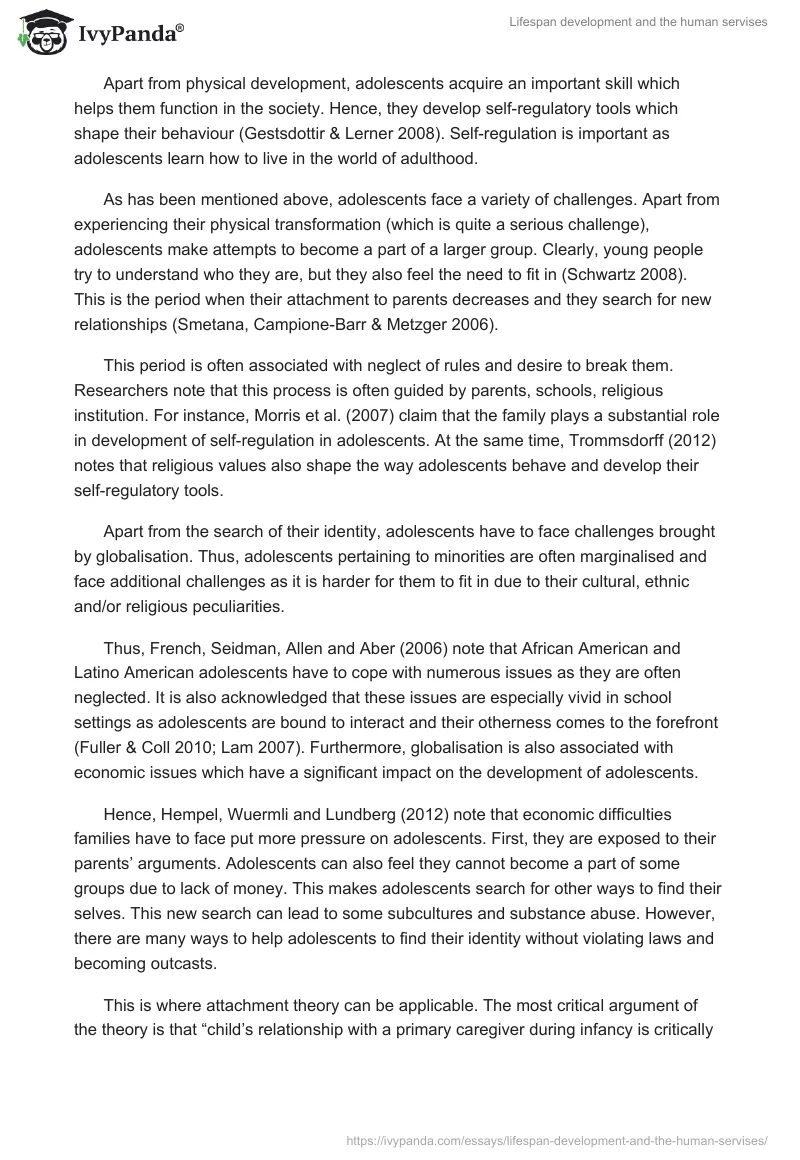Every stage of human development is significant and unique as people develop, acquire new knowledge and adopt new behavioural models.
Thus, in infancy (up to one year), the child is dependent on its parents; in childhood (1-10 years old), children rapidly develop physically, mentally and socially; adolescence (12-18 years old) is characterised by numerous transformations and adulthood is the period of functioning of fully developed individuals, though there can also be certain mental and behavioural transformations (Shaffer & Kipp 2009).
Notably, adolescence stands out as this is the period of considerable emotional turmoil and physical transformation. Adolescents learn how to function in the society and fully develop their behavioural models.
During this period, people have to make a lot of choices and are in search for their selves. From theoretical perspective, this period provides new insights into the attachment theory, which will be discussed below. It is also necessary to note that adolescents are the most vulnerable group in the contemporary society as globalisation and rapid development of technology provides numerous challenges for these young people. Therefore, adolescence is a period which requires special attention.
It is necessary to note that adolescents have to cope with rapid transformation of their bodies. This physical transformation affects psychological development of adolescents to a great extent (Swanson, Edwards & Spencer 2010). Birnbaum and Linver (2013) stress that this is the period when people become active in all respects, i.e. need extra physical activity and are active in forming relationships.
This is the period when young people experience their sexuality and often have their first sexual experience, which can affects further development of their personality (Tolman & McClelland 2011). It is noteworthy that their behaviour often changes and they form new attachments.
Apart from physical development, adolescents acquire an important skill which helps them function in the society. Hence, they develop self-regulatory tools which shape their behaviour (Gestsdottir & Lerner 2008). Self-regulation is important as adolescents learn how to live in the world of adulthood.
As has been mentioned above, adolescents face a variety of challenges. Apart from experiencing their physical transformation (which is quite a serious challenge), adolescents make attempts to become a part of a larger group. Clearly, young people try to understand who they are, but they also feel the need to fit in (Schwartz 2008). This is the period when their attachment to parents decreases and they search for new relationships (Smetana, Campione-Barr & Metzger 2006).
This period is often associated with neglect of rules and desire to break them. Researchers note that this process is often guided by parents, schools, religious institution. For instance, Morris et al. (2007) claim that the family plays a substantial role in development of self-regulation in adolescents. At the same time, Trommsdorff (2012) notes that religious values also shape the way adolescents behave and develop their self-regulatory tools.
Apart from the search of their identity, adolescents have to face challenges brought by globalisation. Thus, adolescents pertaining to minorities are often marginalised and face additional challenges as it is harder for them to fit in due to their cultural, ethnic and/or religious peculiarities.
Thus, French, Seidman, Allen and Aber (2006) note that African American and Latino American adolescents have to cope with numerous issues as they are often neglected. It is also acknowledged that these issues are especially vivid in school settings as adolescents are bound to interact and their otherness comes to the forefront (Fuller & Coll 2010; Lam 2007). Furthermore, globalisation is also associated with economic issues which have a significant impact on the development of adolescents.
Hence, Hempel, Wuermli and Lundberg (2012) note that economic difficulties families have to face put more pressure on adolescents. First, they are exposed to their parents’ arguments. Adolescents can also feel they cannot become a part of some groups due to lack of money. This makes adolescents search for other ways to find their selves. This new search can lead to some subcultures and substance abuse. However, there are many ways to help adolescents to find their identity without violating laws and becoming outcasts.
This is where attachment theory can be applicable. The most critical argument of the theory is that “child’s relationship with a primary caregiver during infancy is critically important to later development and serves as a prototype for the child’s relationships throughout the lifespan” (Washington 2008, p. 8).
Therefore, the closer parents (or a caregiver) and an infant are, the closer tight they will form in the future. In other words, according to this theory, parents can help their child develop strong attachment to them and this will help them avoid numerous issues in their child’s adolescence. This can be true as there are many examples of families where adolescents remain attached to their parents.
However, some researchers have claimed that the theory is out-dated and the period in question is the brightest examples for that. Thus, Smetana (2010) stresses that adolescents tend to alienate themselves for their parents or older relatives as they try to become a part of a group of peers.
Adolescents often find models among their peers and tend to think that older generations simply try to restrict their basic rights. This is one of the major limitations to the theory as it is clear that although some children can be attached to their parents, they can change during their adolescence. A number of transformations (both physical and mental) often shape adolescents’ personality. However, even though this trend is also common, it does not mean that the attachment theory is totally out-dated.
Admittedly, there are certain limitations, but they show that the theory should be considered from a slightly different angle. Thus, it is doubtless that the way caregivers treat children has a significant impact on the child’s development. However, transformations taking place during adolescents can diminish this effect.
At the same time, adolescents do not lose all ties with their parents. Attachment does not disappear, but transforms into new forms. During adolescence, young people tend to form new attachments as they interact with their peers. Thus, the theory can be applied and it can help parents, adolescents, educators, social workers and psychologists assist adolescents find their selves and learn how to live in the society.
In conclusion, it is possible to note that adolescence is one of the most meaningful and difficult periods in people’s lives. This is the period of great physical and psychological transformation. This is also the period when adolescents find their selves and learn how to be a part of the society. Contemporary adolescents often face numerous challenges which are related to globalisation. However, the use of the attachment theory can help researchers find ways to better understand this period.
Reference List
Birnbaum, AS & Linver, MR 2013, ‘Adolescent physical development and health’, in G Creasey & PA Jarvis (eds), Adolescent development and school achievement in urban communities: resilience in the neighbourhood, Routledge, Oxon, pp. 53-65.
French, SE, Seidman, E, Allen, L & Aber, JL 2006, ‘The development of ethnic identity during adolescence’, Developmental Psychology, vol. 42. no. 1, pp. 1-10.
Fuller, B & Coll, CG 2010, ‘Learning from Latinos: contexts, families, and child development in motion’, Developmental Psychology, vol. 46. no. 3, pp. 559-565.
Gestsdottir, S & Lerner, RM 2008, ‘Positive development in adolescence: the development and role of intentional self-regulation’, Human Development, vol. 51. no. 1, pp. 202-224.
Hempel, K, Wuermli, A & Lundberg, M 2012, ‘Adolescence: protecting and promoting human development in times of economic shocks’, Labour Markets and Youth, no. 13, pp. 1-4.
Lam, C 2007, ‘Towards a Chinese conception of adolescent development in a migration context’, The Scientific World Journal, vol. 7. no. 1, pp. 506-518.
Morris, AS, Silk, JS, […] & Robinson, LR 2007, ‘The role of the family context in the development of emotion regulation’, Social Development, vol. 16. no. 2, pp. 361-388.
Schwartz, SJ 2008, ‘Self and identity in early adolescence’, Journal of Early Adolescence, vol. 28. no. 1, pp. 5-15.
Shaffer, DR & Kipp, K 2009, Developmental psychology: childhood & adolescence, Cengage Learning, Belmont, CA.
Smetana, JG 2010, Adolescents, families, and social development: how teens construct their worlds, John Wiley & Sons, Oxford, UK.
Smetana, JG, Campione-Barr, N & Metzger, A 2006, ‘Adolescent development in interpersonal and societal contexts’, Annual Review of Psychology, vol. 57. no. 1, pp. 255-284.
Swanson, DP, Edwards, MC & Spencer, MB 2010, Adolescence: development during a global era, Academic Press, London, UK.
Tolman, DL & McClelland, SI 2011, ‘Normative sexuality development in adolescence: a decade in review’, Journal of Research on Adolescence, vol. 21. no. 1, pp. 242-255.
Trommsdorff, G 2012, Cultural perspectives on values and religion in adolescent development. Web.
Washington, KT 2008, ‘Attachment and alternatives: theory in child welfare research’, Advances in Social Work, vol. 9. no. 1, pp. 8-16.


